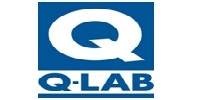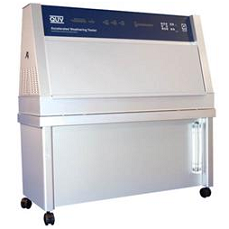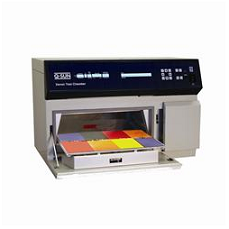***************************************************************************************************************************************************
QUV Accelerated Weathering Tester
The QUV accelerated weathering tester reproduces the damage caused by sunlight, rain and dew. In a few days or weeks, the QUV tester can reproduce the damage that occurs over months or years outdoors.
To simulate outdoor weathering, the QUV tester exposes materials to alternating cycles of UV light and moisture at controlled, elevated temperatures. It simulates the effects of sunlight using special fluorescent UV lamps. It simulates dew and rain with condensing humidity and/or water spray.
The QUV accelerated weathering tester is the simplest, most reliable, and easiest to use weathering tester available. With thousands of testers in use worldwide, it is the world's most widely used weathering tester.
QUV - The World's Most Widely Used Weathering Tester
UV light is responsible for almost all photodegradation of durable materials exposed outdoors. The QUV tester’s fluorescent lamps simulate the critical short-wave UV and realistically reproduce the physical property damage caused by sunlight. Types of damage include color change, gloss loss, chalking, cracking, crazing, hazing, blistering, embrittlement, strength loss and oxidation.
Dew, not rain, is responsible for most of the wetness that occurs in outdoor exposure. The QUV tester's condensation system realistically simulates dew and accelerates its effect using elevated temperature.
The condensation process automatically purifies the ordinary tap water used in the system. This is because the process of evaporating and condensing the water onto the specimens is actually a distillation process, which removes all impurities.
The QUV tester conveniently accommodate up to 48 specimens (75mm x 150mm) and complies with a wide range of international, national, and industry specifications, ensuring the reliability and reproducibility of your test program. Visit our standards page for more information.
Easy to Operate
The QUV tester’s simple, proven design makes it easy to install, easy to use, and almost maintenance-free. It operates completely automatically, 24 hours a day, 7 days a week. Features include:
- Simple user interface for easy programming
- Exposure conditions displayed continuously
- Self-diagnostic warnings and service reminders
- Quick calibration with patented AUTOCAL system
Affordable
The QUV tester is economical to purchase and to operate, because it uses:
- low cost, long life fluorescent UV lamps
- ordinary tap water for condensation
Models (see also Features Tab)
- QUV/basic: UV and condensation (no irradiance control)
- QUV/se: UV, condensation and SOLAR EYE irradiance control
- QUV/spray: UV, condensation, SOLAR EYE irradiance control and water spray
QUV/cw: cool white visible light, condensation and SOLAR EYE irradiance control.
Q-SUN Xe-1 Xenon Test Chamber
The Q-SUN Xe-1 xenon arc chamber reproduces the damage caused by full-spectrum sunlight and rain. In a few days or weeks, the Q-SUN tester can reproduce the damage that occurs over months or years outdoors.
The Q-SUN Xe-1 tester is a tabletop lightfastness, colorfastness, and photostability chamber. It has a single xenon arc lamp and is available with optional water spray and chiller. Its small scale is perfect for a lab with a limited budget or only an occasional need for testing. Installation of the Xe-1 tester is simple and specimens can be conveniently mounted horizontally on its flat specimen tray.
The Q-SUN Xe-1 tester is the simplest, most reliable, and easiest to use xenon arc test chamber available.
A More Realistic Xenon
The Q-SUN Xe-1 tester’s xenon arc lamps provide the best match to the full spectrum of sunlight. Near-horizontal specimen mounting and optional water spray provide the most realistic moisture simulation available in a compact xenon arc tester. An optional chiller is available for low temperature applications.
Easy To Use
The Q-SUN Xe-1 xenon test chamber is easy to install - you can exhaust the Xe-1 directly into the room. It is easy to use and practically maintenance-free. Specimen mounting and evaluation is fast and easy with the unique slide-out specimen tray. The Xe-1 tester is completely automated and can operate continuously, 24 hours per day, 7 days per week. Other features include:
- Remarkably simple user interface
- Built-in Ethernet connection for data logging
- Comprehensive self-diagnostic warnings and service reminders
- Quick and easy calibration with patented AUTOCAL system
Fast Results
A product exposed outdoors to direct sunlight experiences maximum light intensity for only a few hours each day. The Q-SUN Xe-1 tester can subject test specimens to the equivalent of noon summer sunlight for 24 hours a day, every day. Consequently, specimen degradation can be highly accelerated.
Affordable
The Q-SUN Xe-1 tester’s low purchase price, low lamp prices and low operating costs create a breakthrough in the price/performance equation. Now even the smallest lab can afford xenon arc testing.
Models (see also Features Tab)
- Q-SUN Xe-1-B: full spectrum sunlight
- Q-SUN Xe-1-S: full spectrum sunlight and water spray
- Q-SUN Xe-1-BC: full spectrum sunlight and chiller
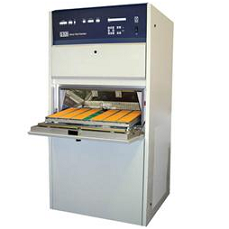
Q-SUN Xe-3 Xenon Test Chamber
The Q-SUN Xe-3 xenon arc chamber reproduces the damage caused by full-spectrum sunlight and rain. In a few days or weeks, the Q-SUN tester can reproduce the damage that occurs over months or years outdoors.
The Q-SUN Xe-3 tester is a full-featured lightfastness, colorfastness, and photostability chamber at a breakthrough price. It utilizes three separate xenon lamps for a large capacity. The Q-SUN Xe-3 tester’s slide out specimen tray is 451mm x 718mm and is useful for exposing large, three-dimensional parts or components. The Xe-3 tester offers standard humidity control, and optional spray, back spray and chiller features.
The Q-SUN Xe-3 is the only xenon arc tester that also has an optional dual spray capability. This allows for a second liquid such as acid rain or soap solutions, to be sprayed onto test specimens.
The Q-SUN Xe-3 is the simplest, most reliable, and easiest to use full-sized xenon arc chamber available.
A More Realistic Xenon
The Q-SUN Xe-3 tester’s xenon arc lamps provide the best match to the full spectrum of sunlight. Near-horizontal specimen mounting and optional water and back spray provide the most realistic moisture simulation available in a xenon arc tester. The Xe-3 tester also is the only xenon test chamber to offer a dual spray option, allowing a second liquid (such as acid rain) to be sprayed onto test specimens. An optional chiller for low temperature applications also allows for simultaneous control of both black panel and chamber air temperature.
Easy To Use
The Q-SUN Xe-3 xenon test chamber is easy to install (proper ventilation required). It is easy to use and practically maintenance-free. Specimen mounting and evaluation is fast and easy with the unique slide-out specimen tray. The Xe-3 tester is completely automated and can operate continuously, 24 hours per day, 7 days per week. Other features include:
- Remarkably simple user interface
- Built-in Ethernet connection for data logging
- Comprehensive self-diagnostic warnings and service reminders
- Quick and easy calibration with patented AUTOCAL system
Fast Results
A product exposed outdoors to direct sunlight experiences maximum light intensity for only a few hours each day. The Q-SUN Xe-3 chamber can subject test specimens to the equivalent of noon summer sunlight for 24 hours a day, every day. Consequently, specimen degradation can be highly accelerated.
Affordable
The Q-SUN Xe-3 tester’s low purchase price, low lamp prices and low operating costs create a breakthrough in the price/performance equation. Now even the smallest lab can afford xenon arc testing.
Models (see also Features Tab)
- Q-SUN Xe-3-H: full-spectrum sunlight with humidity control
- Q-SUN Xe-3-HS: full-spectrum sunlight with humidity control and spray
- Q-SUN Xe-3-HDS: full-spectrum sunlight with humidity control and dual spray
- Q-SUN Xe-3-HBS: full-spectrum sunlight with humidity control and back spray
- Q-SUN Xe-3-HC: full-spectrum sunlight with humidity control and chiller
Q-SUN Xe-3-HSC: full-spectrum sunlight with humidity control, spray and chiller.
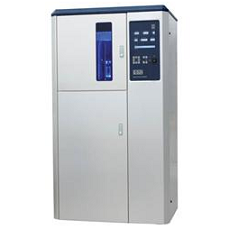
Q-SUN B02 Xenon Test Chamber
The Q-SUN B02 rotating rack xenon arc chamber reproduces the damage caused by full-spectrum sunlight and rain. It was designed specifically to meet the ISO 105 B02 standard for textile lightfastness testing. In a few days or weeks, the Q-SUN B02 tester can reproduce the damage that occurs over months or years outdoors.
The B02 tester is affordable, full-featured, and has a large specimen capacity. It provides precise control of critical test parameters including spectrum, irradiance, relative humidity, chamber temperature and black standard temperature. Water spray is also an available option.
The Q-SUN B02 tester is the simplest, most reliable, and easiest to use rotating rack xenon arc tester available.
Q-SUN B02 – The New Standard in Lightfastness Testing
The revolving drum Q-SUN Model B02 tester was designed specifically to meet the ISO 105 B02 standard for textile lightfastness testing. It uses the latest technology to provide precise control of critical test parameters including spectrum, irradiance, relative humidity, chamber temperature and black standard temperature.
The Q-SUN B02 tester meets many test specifications (visit our standards page for more info), including:
- ISO 105 B02 and B04
- AATCC TM 16 and TM 169, Options 2 & 3
- M&S C9 & C9A
The Q-SUN B02 tester sets the standard with higher specimen capacity than most competitive testers – 31 AATCC prepared samples in 16 holders. Q-SUN B02 specimen holders are very easy to install and remove. ISO and AATCC textile masks are also available.
A More Realistic Xenon
The Q-SUN B02 tester’s xenon arc lamps provide the best match to the full spectrum of sunlight, which is critical for lightfastness testing of most textiles. Vertical specimen mounting, standard RH and optional water spray provide realistic moisture simulation. The unit is capable of simultaneous control of both black panel and chamber air temperature.
Easy To Use
The Q-SUN B02 xenon test chamber is easy to install (proper ventilation required), easy to use and easy to maintain. Specimen mounting and evaluations are fast and easy with easily removed specimen holders. The B02 tester is completely automated and can operate continuously, 24 hours per day, 7 days per week. Other features include:
- Remarkably simple user interface
- Built-in Ethernet connection for data logging
- Comprehensive self-diagnostic warnings and service reminders
- Quick and easy calibration with patented AUTO-CAL system
Fast Results
A product exposed outdoors to direct sunlight experiences maximum light intensity for only a few hours each day. The Q-SUN B02 tester can accelerate results by subjecting test specimens to the equivalent of noon summer sunlight for 24 hours a day, every day. Consequently, specimen degradation can be highly accelerated.
Affordable
The Q-SUN B02 tester was specifically designed to be an affordable lightfastness tester that meets the requirements of ISO and AATCC. The Q-SUN B02 tester’s low purchase price, low lamp prices, and low operating costs set a new standard for lightfastness testing. Now even the smallest lab can afford rotating rack xenon lightfastness testing.
Models (see also Features Tab)
- Q-SUN B02: full-spectrum sunlight, revolving drum specimen holder, with humidity control
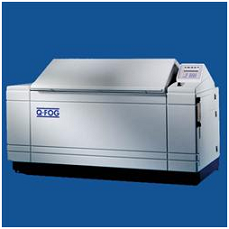
Q-FOG Cyclic Corrosion Tester
Cyclic corrosion testing provides the best possible laboratory simulation of natural atmospheric corrosion. Research indicates that test results are similar to outdoors in resulting structure, morphology, and relative corrosion rates.
Q-FOG cyclic corrosion chambers from Q-Lab can run traditional salt spray, Prohesion, and most cyclic automotive tests. Q-FOG chambers are available in two sizes to fulfill a wide range of testing requirements.
Q-FOG cyclic corrosion testers are the simplest, most reliable, and easiest to use corrosion testers available.
Cyclic Corrosion Testing
Prior to cyclic corrosion testing, conventional salt spray (a continuous salt spray at 35˚C), was the standard way to simulate corrosion in a lab. Because conventional salt spray methods failed to mimic the natural wet/dry cycles of the outdoors, test results frequently provided poor correlation to outdoors.
In a Q-FOG cyclic corrosion tester, specimens are exposed to a series of different environments in a repetitive cycle that mimics the outdoors. Simple cycles, such as Prohesion, may consist of cycling between salt fog and dry conditions. More sophisticated automotive methods may call for multi-step cycles that incorporate humidity or condensation, along with salt spray and dry-off.
Within one Q-FOG chamber, it is possible to cycle through a series of the most significant corrosion environments. Even extremely complex test cycles can easily be programmed with the Q-FOG controller. See LF8110 - Q-FOG Specifications or visit our standards page for a detailed list of test methods met by the Q-FOG chamber.
Q-FOG corrosion test chambers are available in two types. Model SSP performs traditional salt spray and Prohesion tests. Model CCT performs salt spray, Prohesion, and 100% humidity for most cyclic automotive tests.
Easy Programming and Sample Mounting
The Q-FOG test chamber is designed to cycle between four conditions: Fog, Dry-Off, 100% Humidity (Model CCT only), and Dwell. Test conditions, time, and temperature are controlled by a built-in microprocessor. A remarkably simple user interface allows for easy user programming and operation. The operator can quickly create new cycles, or run any of the programmed cycles. The Q-FOG controller includes complete self-diagnostics, including warning messages, routine service reminders and safety shut down.
The Q-FOG tester has a low belt line and an easy opening lid for easy sample mounting. The SSP-600 and CCT-600 models have a capacity of about 160 test panels of 75mm x 150mm in size. The SSP-1100 and CCT-1100 models have a capacity of 240 test panels.
Precise Control of Fog Dispersion
The Q-FOG cyclic corrosion chamber has superior fog dispersion compared to conventional systems, which cannot vary volume and distance independently. A variable speed peristaltic pump controls the amount of corrosive solution delivered to the spray atomizer, while the air pressure regulator controls the distance of the “throw.” Note that purified water is required for proper operation of Q-FOG corrosion testers.
Internal Solution Reservoir
Space utilization is maximized and maintenance is minimized with the Q-FOG tester's internal solution reservoir. The 120 liter reservoir has enough capacity for running most tests for 7 days or more. The reservoir has an integral salt filter and a built-in alarm to alert the operator when the solution is low.
Fast Cycling
Q-FOG testers can change temperatures exceptionally fast because of their unique internal chamber heater and their high volume cooling/dry-off blower. An additional air heater allows very low humidity dry-off exposures. Conventional chambers with water jackets cannot cycle rapidly because of the thermal mass of the water, nor can they produce low humidity.
Affordable
Q-FOG cyclic corrosion testers offer state of the art corrosion testing technology, reliability, ease of operation and easy maintenance – all at a remarkably affordable price.
Models (also see Features Tab)
- Q-FOG SSP-600: conventional salt spray and Prohesion tests, 640 liter chamber volume
- Q-FOG SSP-1100: conventional salt spray and Prohesion tests, 1103 liter chamber volume
- Q-FOG CCT-600: conventional salt spray, Prohesion, and 100% humidity, 640 liter chamber volume
Q-FOG CCT-1100: conventional salt spray, Prohesion, and 100% humidity, 1103 liter chamber volume

QCT Condensation Tester
The QCT condensation tester simulates the damaging effects of outdoor moisture attack by condensing warm water directly onto test specimens. In a few days or weeks, the QCT tester can reproduce the damage due to moisture that occurs over months or years outdoors.
The QCT tester is fast, easy to use and affordable. It uses 100% condensing humidity to simulate and accelerate damage caused by rain and dew on metals, paints, and organic materials. It accelerates over natural exposures by increasing moisture temperature. The QCT tester replaces water immersion and ordinary (non-condensing) humidity tests.
The QCT condensation tester is used in thousands of labs in over 50 countries. It is the simplest, most reliable, and easiest to use condensation tester available.
Effects of Outdoor Moisture
Water is a common enemy to most materials. It causes metals to corrode, organics to decompose, and structures to disintegrate. Condensation is water that has been distilled from impure water, mixed with the atmosphere, and saturated with oxygen. This type of moisture has also been called “aggressive water”, because it carries oxygen with it as it contacts a material or diffuses through a coating. Studies show that materials outdoors are exposed to an average of 12 hours per day of condensed water in the form of dew.
The QCT Condensation Tester
The QCT tester uses 100% condensing humidity to simulate and accelerate damage caused by dew on metals, paints, and organic materials. It accelerates over natural exposures by increasing moisture temperature.
The QCT tester requires only ordinary tap water. This is because the tap water becomes pure distilled water in the process of evaporation from the water pan and condensing onto the specimens.
The tester's innovative design utilizes room air cooling to create a temperature differential across the thickness of the specimens. This temperature differential is a necessary element for condensation to occur. It is important to note that the QCT tester is fundamentally different from a typical humidity tester.
Variable Exposure Cycles
The user is able to program the QCT tester to create static, 100% condensing humidity or to cycle between hot condensation and dry-off. The temperature’s range extends from room temperature to as high as 70 degrees Celsius. The system allows for the selection of almost any desired wet/dry exposure cycle through an automatic cyclic timer. The cycle options range from the subtle wetness of an almost invisible dew a few degrees above room temperature, to a continuous, high-temperature, running condensate.
Freezing accelerates some failures. For a freeze/thaw cycle, panels can be manually removed from the QCT while wet and immediately frozen, and then reinserted into the tester.
Fast and Versatile
The QCT tester can be used to:
- screen paints for blister resistance over a weekend at 55 degrees Celsius
- evaluate oil-based rust inhibitors in less than 120 hours at 38 degrees Celsius
- rate effectiveness of mill-applied oils in only a day
- test surface reactivity of cold-rolled and galvanized steel in hours
- test wood finishes for blistering, moisture and mold resistance
Easy to Use, Simple to Install
The QCT tester provides instant blister or corrosion testing - just plug it in and add water. The unit can be placed anywhere in your office, lab, or plant. The heat and water vapor produced by the QCT tester is about the same as that produced by one additional person in the room. Also, the test panels on a QCT unit may be inspected as often as you want, without altering test conditions. Just remove the panel and put a blank in its place.
Standards
The QCT tester conforms with several standards, including:
- ASTM D4585, Testing Moisture Resistance of coatings with Controlled Condensation
- ISO 6270-1, Paints and Varnishes - Humidity (Continuous Condensation)
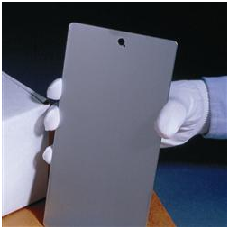
Q-PANEL Standard Substrates
For over 50 years, Q-PANEL test substrates have been recognized as the world standard for a consistent and uniform test surface for paints, plating, adhesives, sealants, rust inhibitors and other coatings.
Thousands of labs around the world use millions of our steel and aluminum panels every year for color development, weathering exposures, salt spray and corrosion testing, physical properties testing and quality control. A wide range of panel sizes and types are available for immediate shipment from stock.
Look for the Q-shaped hole. It's our trademark and your assurance of quality.
If coatings tests are to be reliable and reproducible, they must be performed on a substrate which is reasonably consistent from test to test. Unfortunately, ordinary commercial sheet steel displays wide variations in the surface properties which affect the bonding of coatings.
Sources of Variability
Surface problems can come from a number of sources:
- Surface texture varies with the condition of the rollers used by the steel mill to cold roll the steel to its final thickness.
- Surface cleanliness varies with the mill’s cleaning procedure, especially the procedures used to control carbon smut. All too often, carbon smut is actually baked onto the steel during the high temperature annealing process which follows rolling. This carbon smut is impossible to remove except by mechanical abrasion.
- Rust varies with the care taken in handling (a) at the steel mill, (b) during transport and storage, and (c) during fabrication.
- Steel stored for a long time with rust inhibiting oil will react to form an incomplete oxide known as oil stain.
The result is that ordinary steel is unsuitable for many coatings tests. Although some commercial steel provides an excellent surface for coatings, you are just as likely to find steel which gives poor adhesion and poor rust resistance even with good coatings. In fact a single mill will often produce both very good and very poor surface quality, depending upon a number of uncontrolled factors. Cleaning and phosphating help, but they cannot overcome surface defects formed at the mill.
Q-PANEL steel and aluminum test substrates from Q-Lab minimize metal variability as a source of bias in critical paint, coating and adhesion tests. They are clean, consistent, convenient, and economical.
Clean
The Q-PANEL production process thoroughly cleans panels and removes any oil from the surface. Special handling assures that all panels are completely clean when they are packaged. Steel panels are packed in plastic bags in quantities of 20 to 50 panels (depending on type and thickness), with a vapor phase rust inhibitor inside a sturdy cardboard carton, for a shelf life of several years. Aluminum panels are packed similarly, except without the rust inhibitor.
Consistent
Three factors assure Q-PANEL substrates are consistent, high quality and low cost:
- volume metal purchasing from selected mills
- automated production on a high-speed line
- rigorous inspection at several processing stages
Convenient
Panels are supplied pre-cleaned, with a 6mm (¼”) Q-shaped hole (it’s our trademark and your assurance of quality). For safety and ease of handling, the panels have rounded corners and deburred edges. Our inventory of over a million paint test panels means that 95% of our orders are shipped from stock. In most cases panels can be used right out of the box.
Economical
Because of high volume production, Q-PANEL substrates cost less than you might expect for a standardized surface. Purchasing clean, safe, standardized panels reduces the time lab personnel must spend cleaning and handling panels.
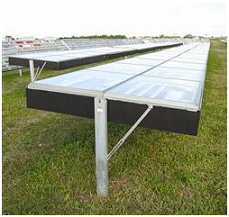
Q-RACK Outdoor Exposure Racks
Q-RACK outdoor exposure racks are the same aluminum racks that are used at Q-Lab Florida and Q-Lab Arizona to perform natural outdoor exposure tests. Now you can buy these professional quality racks to perform exposures at your own site.
The durable Q-RACK design has been proven over decades of harsh subtropical and desert exposures. The racks are versatile, dependable, and affordable, and come in kit form for easy assembly.
Q-RACK kits, accessories and non-standard mounting systems are available for different applications and testing requirements. They meet ISO, ASTM, SAE and other international standards for outdoor testing. The Q-RACK frame may be positioned at 0°, 5°, 45° or 90°.
Q-RACK Outdoor Exposure Racks
Q-RACK outdoor exposure rack kits are available in two types: direct exposure and under glass exposure. See LR-3001 - Q-RACK Brochure for photos and more detailed information.
In direct exposure racks, specimens are directly exposed to the environment. It is the most common method for testing coatings, inks, plastics, or finishes used outdoors. Most typical test specimens can be easily mounted on a Q-RACK direct exposure system. Our direct exposure rack kits meet the requirements of ISO 877-2 Method A, ASTM G7, ASTM D4141, or SAE J1976. Be sure to visit our Standards Page for other information about relevant standards for Q-RACK systems or our other products and services.
Under glass exposure racks are primarily used to test automotive interior materials. Specimens are exposed to sunlight behind special glass panels.
Direct Exposure Rack Kits:
- FL-3049-K Welded Frame Direct Exposure Rack Kit – North America Shipment Only
- FL-3055-K Knock Down Frame Direct Exposure Rack Kit – Available for Shipment Globally
- FL-3120-K Black Box Direct Exposure Rack Kit – North America Shipment Only
Under Glass Exposure Rack Kits:
- FL-3086-K Under Glass Exposure Rack Kit – North America Shipment Only
- FL-3121-K Black Box Under Glass Exposure Rack Kit – North America Shipment Only
